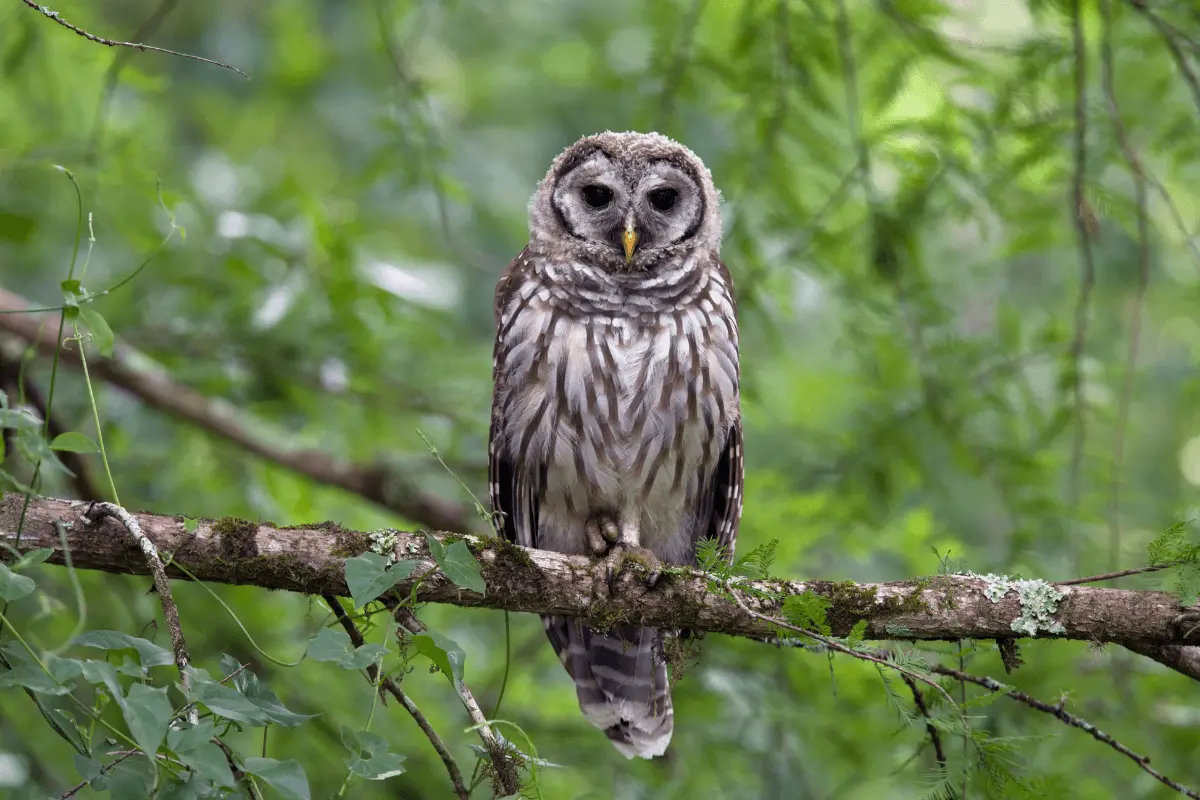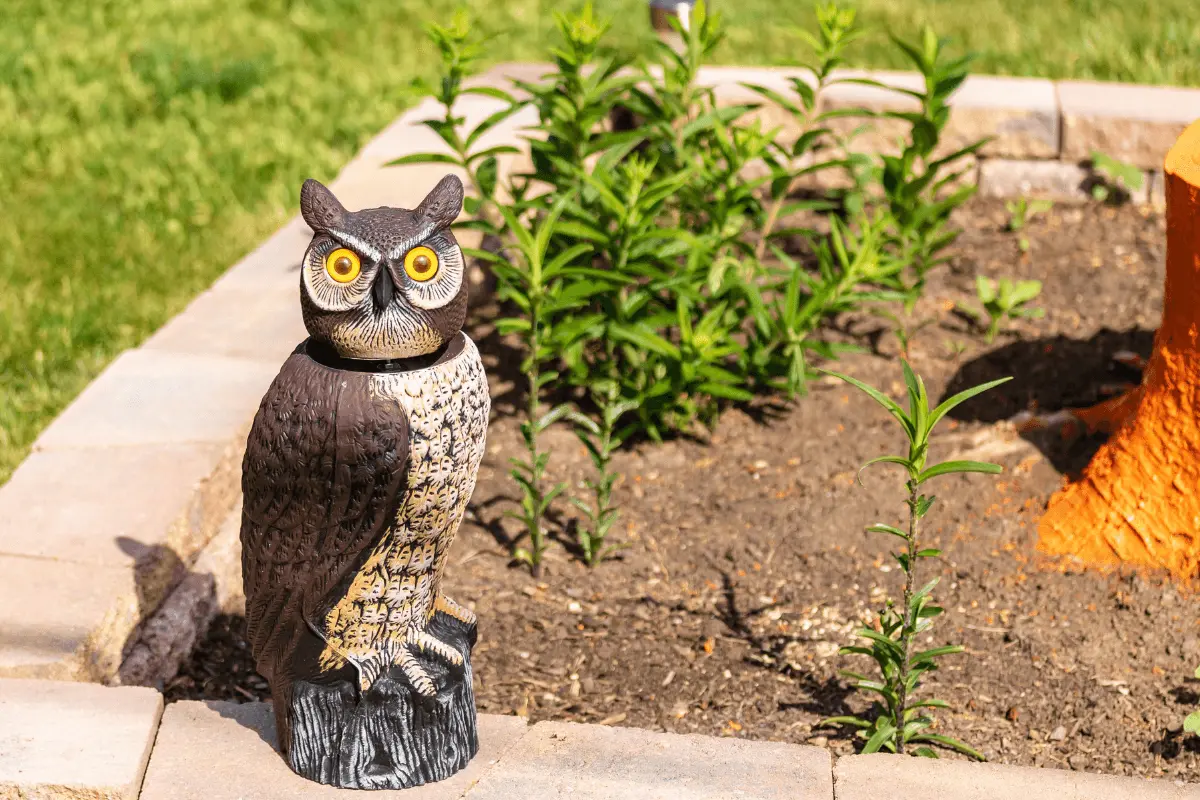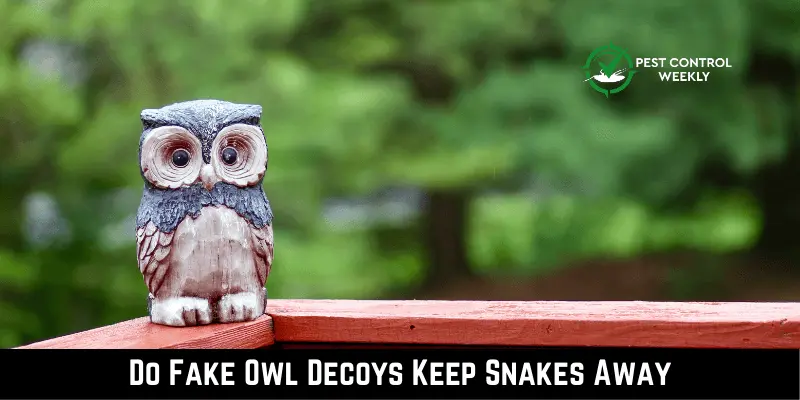Are you sick of having snakes in your garden or lawn when you don’t want them there? The use of an owl is frequently mentioned as one of the solutions that people consider. But do fake owl decoys keep snakes away?
Yes, fake owl decoys keep snakes away. As natural hunters of many snake species, owls are important for keeping snake populations under control. Using this fact, fake owl decoys have been made as a more effective way to keep snakes away.
This article explores owls’ predatory abilities, the benefits they provide to gardens, and the viability of fake owls for controlling snake populations, among other topics relevant to their place in ecosystems.
The Role Of Owls In The Ecosystem

The owl’s position as a top predator in many food webs has significant ecological implications. Owls play a crucial role in biodiversity by keeping populations of rodents, insects, and even snakes under check with their skillful nighttime hunting.
As biocontrol agents, they help maintain biodiversity and a healthy ecosystem. In addition, the nutrients in their waste aid plant development and contribute to nutrient cycling. Culturally and symbolically, owls bring depth to our perception of nature with their mysterious hoots and silent wings.
Owls as Predators
According to BoD – Books on Demand chapter 5 owls are the masters of the night in the complex natural tapestry. Their strong talons and ability to turn their heads 270 degrees make them dangerous predators. With their keen senses of hearing and sight, they can manage populations of rodents, insects, and snakes by striking with pinpoint accuracy.
The delicate balance of biodiversity depends on their work as apex predators. The predatory abilities of owls help control the proliferation of prey species, which in turn helps control pest populations and illness. When they are present, it usually means that the ecology is doing well.
Benefits of Owls in Your Garden
Inviting owls to make your garden their home might have far-reaching effects. When it comes to controlling rodent populations, they are second to none. This means less potentially dangerous pesticides may be used. As a bonus, they provide an environmentally benign pest management method by eating slugs, snails, and caterpillars.
Owls’ waste is rich in nutrients that are beneficial to plant growth. The mysterious presence of owls may offer a new dimension of fascination to your garden while encouraging the growth of a rich and stable ecology there.
How Do Fake Owls Work As Deterrents?

Artificial owl decoys are effective snake deterrents because they rely on the same concept as real owls: biological mimicry. Many snake species have natural predators, and these decoys trick them into thinking one is nearby. Therefore, the snakes are deterred from staying in the vicinity since the decoy itself is a possible hazard.
These decoys will only be effective if they look and act like real animals. Critical to their effectiveness are specifics like size, coloring, and even motion if feasible. Adding realism and making the decoy seem more menacing to a cautious snake with a revolving head or hooting sound is a great idea.
However, fake owls are not 100% effective as a deterrent. Some snakes could get used to the decoy’s constant, passive presence and stop reacting. Therefore, owl decoys shouldn’t be considered as a stand-alone remedy but rather as part of a larger, more complete approach to snake management.
Effectiveness of Fake Owls
Studies and Research Findings
Using fake owls as deterrents has been the subject of many studies, with different effects. Some studies have shown that the decoys are initially successful in reducing the population of snakes. The decoys are so realistic that they trick the animals into thinking they are in a safe environment, which in turn drives them to look elsewhere.
However, it’s crucial to remember that the effects don’t last forever. Numerous studies have shown that pests eventually acclimate to a static decoy and stop taking precautions against it. The decoy’s effectiveness as a deterrent is diminished due to habituation. Interestingly, studies suggest that adding motion or sound to the decoy might help solve this issue, extending its useful life by keeping it threatening to the target.
Limitations and Factors To Consider For Owl Decoys
While owl decoys may be used as a non-lethal, environmentally friendly method of pest control, they do have their drawbacks. Their usefulness is typically short-lived and very context-dependent. The effectiveness of a decoy depends on a number of factors, including the species and behavior of the pest, how realistic the decoy is, and the local predator-prey dynamics.
One major drawback is that snakes might become accustomed to the decoy and stop being scared of it. To combat this, it might be useful to periodically relocate the decoy and incorporate other components of motion. Decoys that look like actual owls in terms of size, color, and posture are more likely to be successful than those that don’t.
The local environment should be taken into account as well. The decoy may be unsuccessful if pests do not associate owls with danger since they are not a natural predator in the region. Consequently, despite their advantages, fake owl decoys should not be used as the only technique of pest management but rather as part of a larger, more comprehensive approach.
Tips for Using Fake Owls
Placement of Fake Owls
Placing false owl decoys is important for their success as snake scarers. Decoys should be positioned in high, visible areas to mimic the perching behavior of real owls. The decoy’s field of view should also include the region you’re trying to shield.
Because snakes live on the ground and gaze upward for danger, seeing an owl perched high up is a very effective deterrent. A fake owl will be more convincing if placed in areas where snakes are likely to encounter real owls.
Periodic Movement
Adding in some regular motion may do wonders for how convincing the decoy seems. This lessens the likelihood that the snake will acclimate to the decoy’s constant presence and stop seeing it as dangerous. To keep the decoy seeming like a real hunting predator, it is important to move it about often or choose a model with some motion, such a turning head or flapping wings.
Pairing with Other Deterrents
Fake owls should be used in tandem with other snake deterrents to be most effective. It is possible to construct a more thorough and successful strategy by combining visual, aural, and olfactory deterrents. The total deterrent impact, for instance, may be improved by combining the decoy with the usage of snake-repelling plants or medicines.
Devices that make noises similar to an owl’s hoots can help reinforce the fact that a predator is around. Remember that the key to long-term success in controlling snakes is typically an interdisciplinary, multi-pronged strategy.
Alternatives to Fake Owls
Natural Snake Repellents
Instead of using false owls, you may use nature’s inherent defenses to keep snakes away. Plants like marigolds, lemongrass, and wormwood are known for keeping snakes away. They give out smells that snakes find unpleasant, functioning as a deterrent. Clove and cinnamon essential oils can also create a fragrant perimeter around your home. Remember, though, that different repellents will have different levels of effectiveness and that you may have to reapply it often to keep it working.
Physical Barriers
Another feasible strategy to stop snake invasions is to put up physical barriers. Fencing specifically constructed to deter snakes from entering a building or other place can be installed. To prevent snakes from climbing over or tunneling under, the fence should be set into the ground by a few inches and slanted outward at a 30-degree angle. Snakes can be deterred by eliminating clutter and hiding places in your yard.
Professional Snake Removal
DIY snake removal strategies have their uses, but professional services are the safest choice. Professionals can catch and move snakes in a way that is safe for both the snakes and those around them. They are also a great resource for snake-proofing your home by helping you detect potential entry points and deterrents. Always ask for help from professionals if a deadly snake is detected. Only those with experience should handle snakes because they are deadly.
How Do Real Owls Help Control Snake Populations?
Owls help control snake populations in nature’s food webs. Owls, being top nocturnal predators, are snakes’ natural enemies. Their keen hearing, strong talons, and excellent low-light eyesight enable them to hunt snakes.
Owls maintain environmental balance by feeding on snakes. Their predation reduces domestic snake encounters. Owl-snake interactions are complicated and vary among environments and species. Owls may not dissuade braver snakes. However, owls can block snakes from entering the perceived danger zone, creating an organic, self-sustaining control system.
Conclusion
In conclusion, owl decoys made to look real can be an effective means of warding off snakes. However, their efficiency is complicated by factors including the snake species in question, the location of the decoys, and the realism of the decoys themselves. They may help in the short term, but you should combine them with additional methods including natural deterrents, physical barriers, and pest control experts.
The long-term, natural solution to snake control may lie in encouraging a robust population of actual owls. Sustainable, peaceful solutions to problems like pest control need an appreciation for, and an understanding of, the delicate balance of our local ecosystems.
